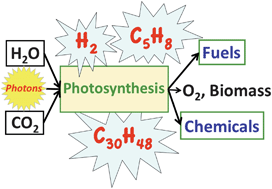100 years ago an Italian chemist predicted that one day human beings would use sunlight to make fuel.
Professor Giacomo Ciamician, nine-time Nobel Prize nominee, envisaged a time when human beings would use “processes that hitherto have been the guarded secret of the plants” to harvest sunlight and make fuel.
To celebrate the remarkable recent scientific advances towards achieving this dream, the RSC has created a collection articles by leading international scientists as well as original commentaries setting out their opinions about the future. All articles in the collection are free to access until 27th October 2012.

“Fast food” energy – Daniel Nocera argues that new research and development is needed to provide the nonlegacy world with the “fast food” equivalent of solar energy—light-weight and highly manufacturable solar capture and storage systems (Energy Environ. Sci., 2010,3, 993-995).
Running on sun – five international experts discuss the promise of artificial photosynthesis and the challenges that lie ahead (Published on the 25th of September 2012).
Which energy solution is best?
Review of solutions to global warming, air pollution, and energy security – Mark Jacobson reviews and ranks major proposed energy-related solutions to global warming, air pollution mortality, and energy security (Energy Environ. Sci., 2009, 2, 148-173).
Learning from Nature
Photosynthetic energy conversion: natural and artificial – James Barber asks: can we address the energy/CO2 problem by developing new photochemical technologies which mimic the water splitting enzyme of photosynthesis? (Chem. Soc. Rev., 2009, 38, 185-196).
Recent advances in hybrid photocatalysts for solar fuel production – Joachim Loo and colleagues investigate how to make robust photocatalytic hybrid
Photosynthesis-to-fuels: from sunlight to hydrogen, isoprene, and botryococcene production – Anastasios Melis explains how the primary products of photosynthesis can be transformed directly, in a single organism, into useful fuels and chemicals for human consumption (Energy Environ. Sci., 2012, 5, 5531-5539).
Raising awareness
Solar Fuels and Artificial Photosynthesis: Science and innovation to change our future energy options is a non-technical RSC report introducing the potential of solar fuels to become a viable alternative in our future energy landscape.
Additional resources:
Living healthy on a dying planet
Daniel G. Nocera
Chem. Soc. Rev., 2009, 38, 13-15
Nanomaterials for renewable energy production and storage
Xiaobo Chen, Can Li, Michaël Grätzel, Robert Kostecki and Samuel S. Mao
Chem. Soc. Rev., 2012, DOI: 10.1039/C2CS35230C
Comparison of primary oxidants for water-oxidation catalysis
Alexander R. Parent, Robert H. Crabtree and Gary W. Brudvig
Chem. Soc. Rev., 2013, DOI: 10.1039/C2CS35225G
Polyoxometalate water oxidation catalysts and the production of green fuel
Hongjin Lv, Yurii V. Geletii, Chongchao Zhao, James W. Vickers, Guibo Zhu, Zhen Luo, Jie Song, Tianquan Lian, Djamaladdin G. Musaev and Craig L. Hill
Chem. Soc. Rev., 2012, DOI: 10.1039/C2CS35292C
Powering the future of molecular artificial photosynthesis with light-harvesting metallosupramolecular dye assemblies
Peter D. Frischmann, Kingsuk Mahata and Frank Würthner
Chem. Soc. Rev., 2013, DOI: 10.1039/C2CS35223K
A quantum-chemical perspective into low optical-gap polymers for highly-efficient organic solar cells
Chad Risko, Michael D. McGehee and Jean-Luc Brédas
Chem. Sci., 2011,2, 1200-1218
Enzymes and bio-inspired electrocatalysts in solar fuel devices
Thomas W. Woolerton, Sally Sheard, Yatendra S. Chaudhary and Fraser A. Armstrong
Energy Environ. Sci., 2012,5, 7470-7490
Fuel production from CO2 using solar-thermal energy: system level analysis
Jiyong Kim, Terry A. Johnson, James E. Miller, Ellen B. Stechel and Christos T. Maravelias
Energy Environ. Sci., 2012, DOI: 10.1039/C2EE21798H
Plasmonic solar water splitting
Scott C. Warren and Elijah Thimsen
Energy Environ. Sci., 2012, 5, 5133-5146
Visible light-driven water oxidation—from molecular catalysts to photoelectrochemical cells
Lele Duan, Lianpeng Tong, Yunhua Xu and Licheng Sun
Energy Environ. Sci., 2011, 4, 3296-3313
Artificial photosynthetic systems. Using light and water to provide electrons and protons for the synthesis of a fuel
Christian Herrero, Annamaria Quaranta, Winfried Leibl, A. William Rutherford and Ally Aukauloo
Energy Environ. Sci., 2011, 4, 2353-2365
Also of interest
Specialist Periodical Reports on Photochemistry
Molecular Solar Fuels
Edited by Thomas J Wydrzynski and Warwick Hillier
The ‘belle époque’ of photochemistry
Angelo Albini and Valentina Dichiarante
Photochem. Photobiol. Sci., 2009,8, 248-254
A tribute to Stanislao Cannizzaro, chemical informationist and photochemist
Heinz D. Roth
Photochem. Photobiol. Sci., 2011,10, 1849-1853
You may also enjoy these related themed collections:
Biomimetic approaches to artificial photosynthesis – an Energy & Environmental Science themed issue
Artificial Photosynthesis – a Faraday Discussion
Artificial Photosynthesis – a ChemComm web collection
Renewable energy – a Chem Soc Rev themed issue
Photosciences: a look into the future – a Photochemical & Photobiological Sciences part themed issue











